
China has said that it would “unswervingly” stick to its zero-COVID policy, dampening the outlook for global markets following their recent surge on hopes that Beijing would cast aside some of its economically damaging virus curbs.
China is the last major economy wedded to a strategy of extinguishing outbreaks as they emerge, imposing snap lockdowns, mass testing and lengthy quarantines despite the widespread disruption to businesses and international supply chains.
Stock markets climbed on Nov. 4 in part on unsubstantiated rumours that Beijing was poised to announce significant changes to the policy or even lay out a path towards a full reopening.
But authorities poured cold water on the speculation, with National Health Commission (NHC) spokesperson Mi Feng confirming on Nov. 5 that Beijing would “stick unswervingly to... the overall policy of dynamic zero-COVID”.
The thousands of domestic cases logged last week represent a tiny fraction of the country’s vast population, but have been enough for officials to take drastic action - sometimes with unpopular or tragic consequences.
Officials on Nov. 5 criticised the use of “excessively layered” and “one-size-fits-all” policies in some locales but insisted the overall zero-tolerance virus approach was “correct”.
But a reopening still appears to be a long way off, with areas contributing over 10 percent of China’s overall gross domestic product under some form of enhanced virus curbs, according to a calculation by Nomura.
The Japanese bank also warned that the impact of any policy easing “would likely be very limited” and said it foresaw a “very small probability to materially ending (zero-COVID) before March 2023”.
China’s year-on-year economic growth rebounded to 3.9 percent in the third quarter of this year, but analysts still expect Beijing to miss its stated goal of around 5.5 percent annual GDP growth by a wide margin.